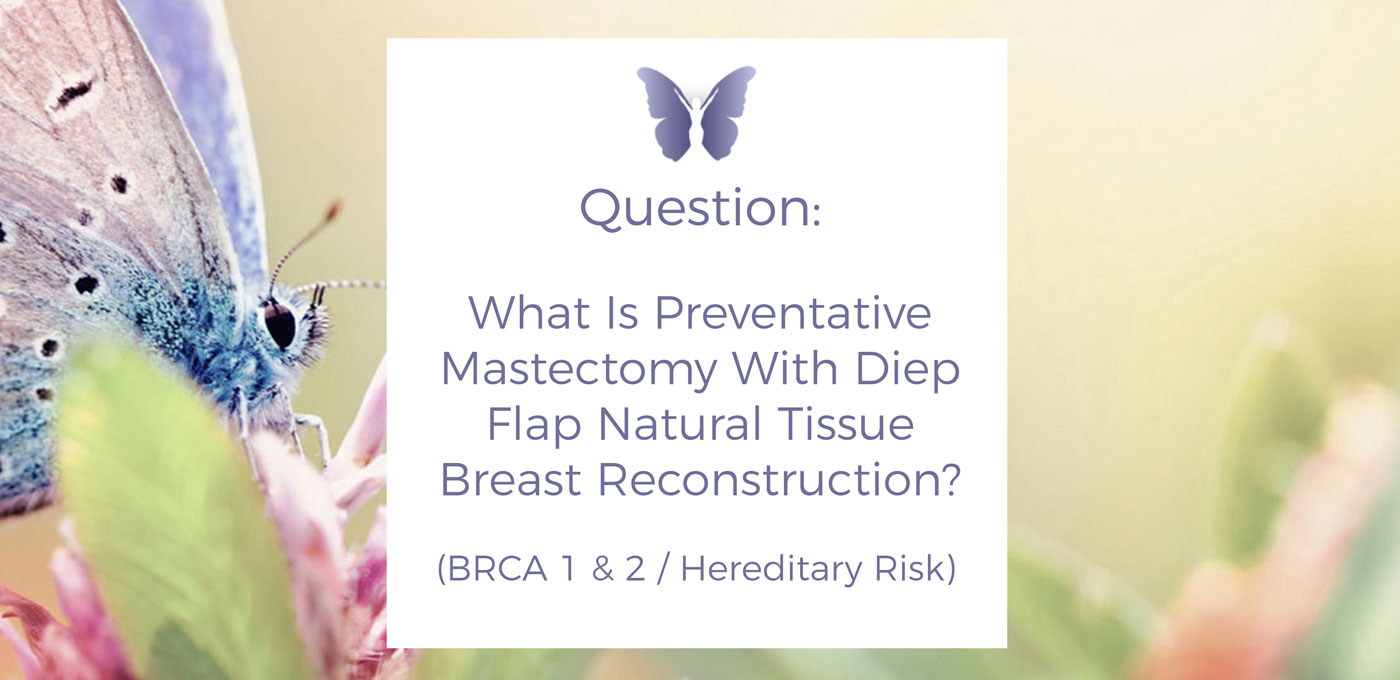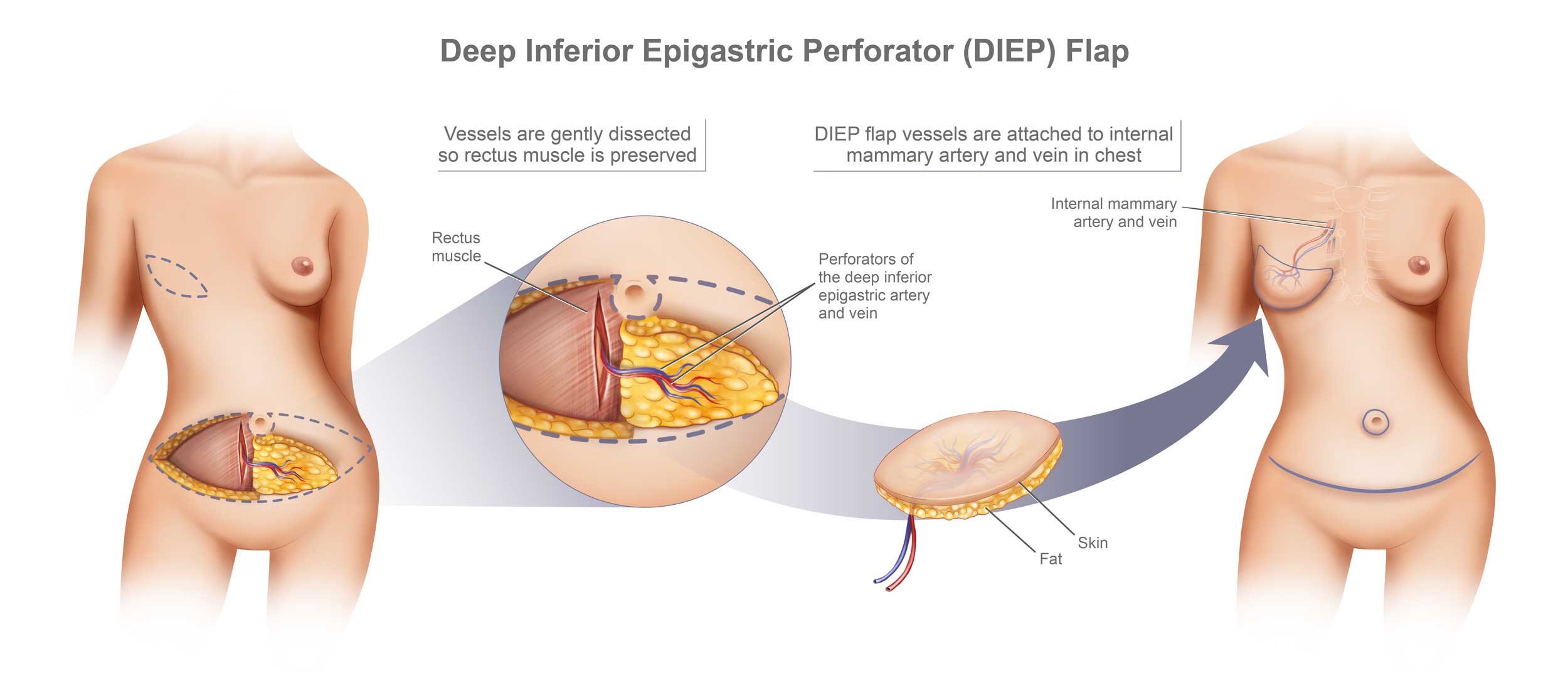
What is Preventative Mastectomy With Diep Flap Natural Tissue Breast Reconstruction?
Preventative Mastectomy with DIEP flap| Intro
Many women with a genetic predisposition for increased risk of breast cancer (BRCA 1 & 2) choose to have a preventative mastectomy with DIEP flap natural tissue breast reconstruction.
Patients with breast cancer may be offered surgical treatment that includes the removal of the tumor. This is called lumpectomy and is associated with radiation therapy. The other surgical option is mastectomy. This includes the removal of the entire breast.
The removal of the entire breast does not necessarily mean the removal of the skin around the breast, and most mastectomies are called skin-sparing mastectomies, meaning that the skin around the breast is not removed. In some cases, the nipple can also be preserved, and these procedures are called nipple-sparing mastectomy.
Preventative Mastectomy with DIEP flap | Defining Prophylactic Mastectomy
Patients with cancer on one side may also be offered a mastectomy on the other side. If the other breast is removed even though it doesn’t contain any cancer, this procedure is called prophylactic mastectomy. A prophylactic mastectomy is a mastectomy in which the breast is removed in order to reduce the risk of developing cancer in the future.
Prophylactic mastectomy may also be recommended for patients who are at extremely high risk for developing breast cancer in the future. These patients include patients with a very strong family history, meaning that there are members of their immediate family who have had breast cancer, or patients who have been identified as carriers of a gene mutation which predisposes them for a very high risk of breast cancer. The most common gene mutation for which prophylactic mastectomy is offered is the BRCA gene mutation.
Preventative Mastectomy with DIEP | Breast Reconstruction After Prophylactic Mastectomy
After prophylactic mastectomy, the breast is reconstructed. The options for breast reconstruction include implant reconstruction or autologous reconstruction, meaning the use of the patient’s own body tissue.
Autologous breast reconstruction has many advantages in that it is permanent and it is living soft tissue. The most sophisticated way to approach autologous breast reconstruction is with procedures called perforator flaps.
The most common perforator flap is the DIEP or deep inferior epigastric artery perforator flap. These surgeries allow surgeons to take healthy living tissue from the patient’s body, like from the abdomen, and remove it without destroying the underlying muscle. The living tissue is taken with its blood supply. These blood vessels perforates through the underlying muscle and, therefore, these procedures are called perforator flaps.

Click image to see enlarged pop-up
RELEVANT LINKS:
- The 6 Benefits of DIEP Flap Reconstruction
- About BRCA / Hereditary Risk and Natural Tissue Breast Reconstruction
- About the DIEP Flap Breast Reconstruction Procedure
- Comparing Breast Implants vs. Natural Tissue Reconstruction
- DIEP Flap Before and After Photo Gallery | Dr. Levine’s Patients Results
- True-Muscle Sparing Natural Breast Reconstruction Options
Dr. Joshua L. Levine, MD FACS
World Leading Authority in Perforator Flap Breast Reconstruction
Based in New York, New Jersey, and Connecticut

Dr. Joshua Levine is a world-renowned perforator flap breast reconstruction surgeon. Meaning, all of his breast reconstruction procedures, are muscle-sparing, using only your own natural tissue to restore your breast(s). He operates out of top cutting-edge and award-winning hospital facilities in New York, New Jersey, and Connecticut, alongside a hand-selected surgical team that matches his expertise. He’s been pioneering advancements in the field of perforator flap breast reconstruction since the beginning of his career in 2004, and has completed over 1,700 successful reconstruction procedures.

Nelly K.
Dr. Levine Has restored what cancer took from me. He is caring, compassionate and a true artist. It is virtually impossible to tell that my breasts are not my ‘originals’

![]()

Rena H.
Dr Levine is an outstanding Doctor. He is a wonderful human being and a highly skilled surgeon. My results are nothing short of miraculous. There is no one like Doctor Levine. He is an artist and a true professional.

![]()


